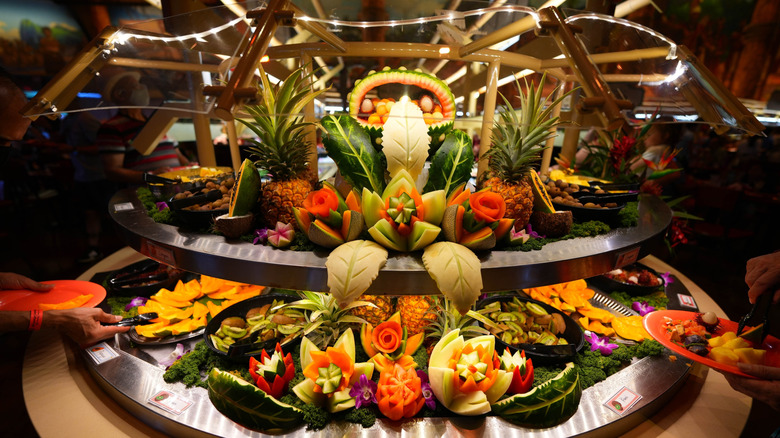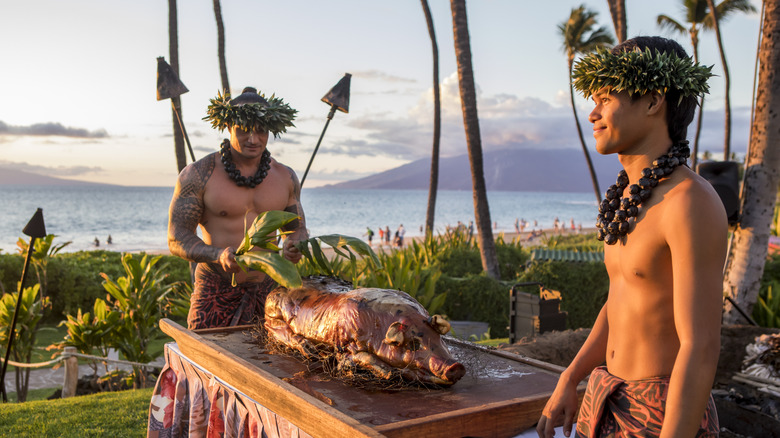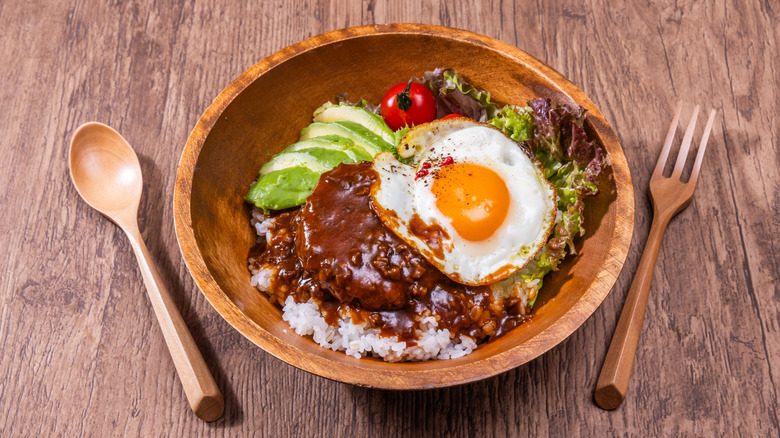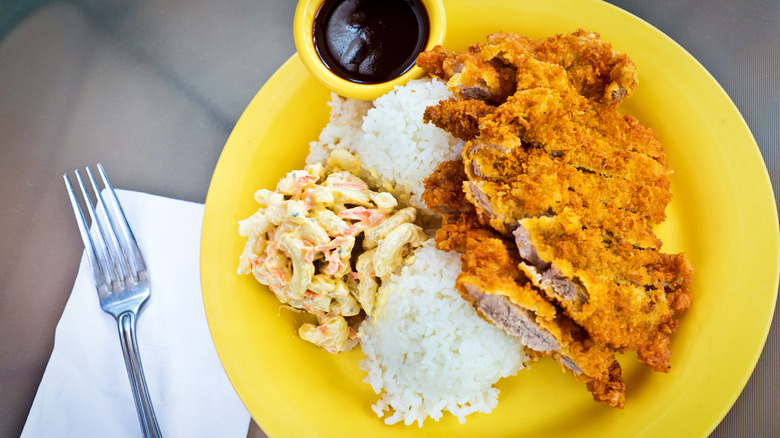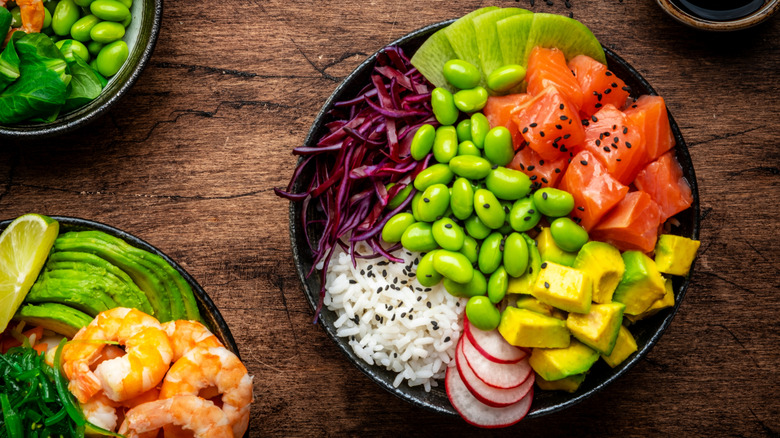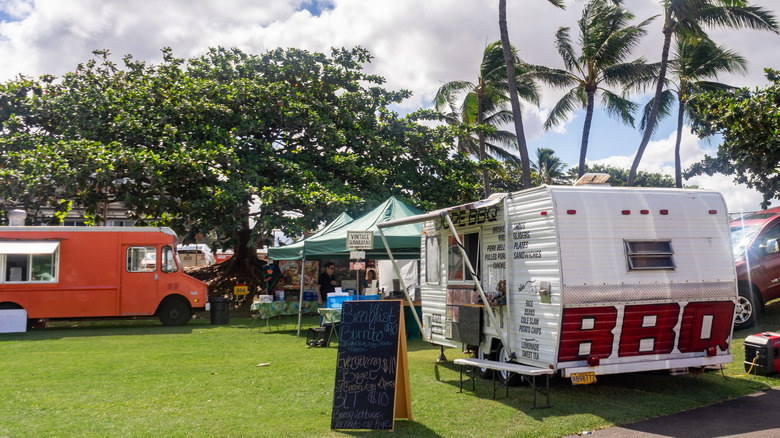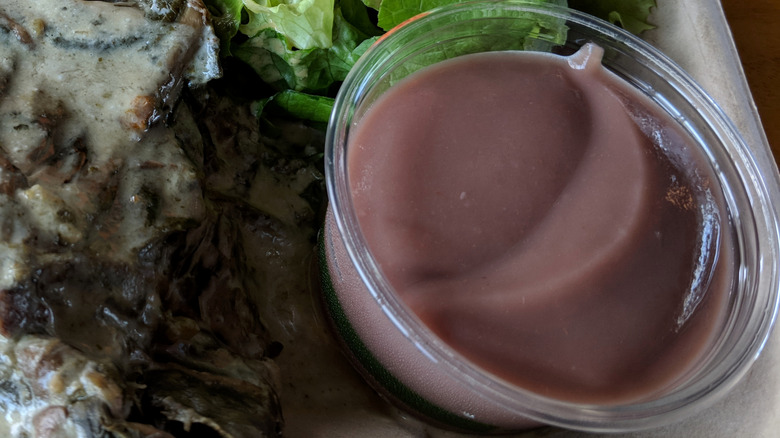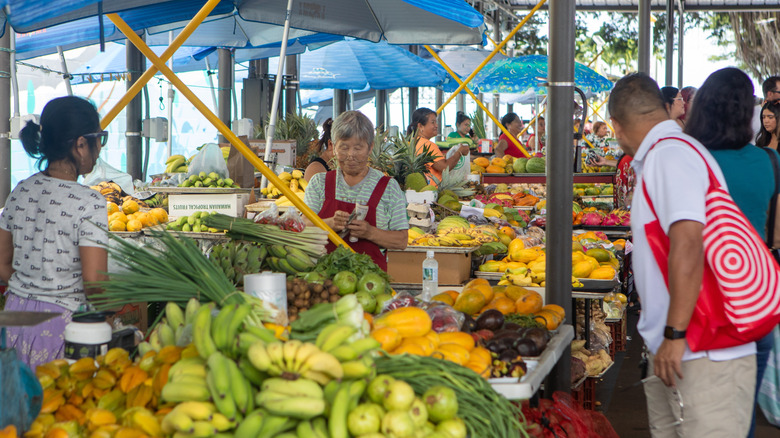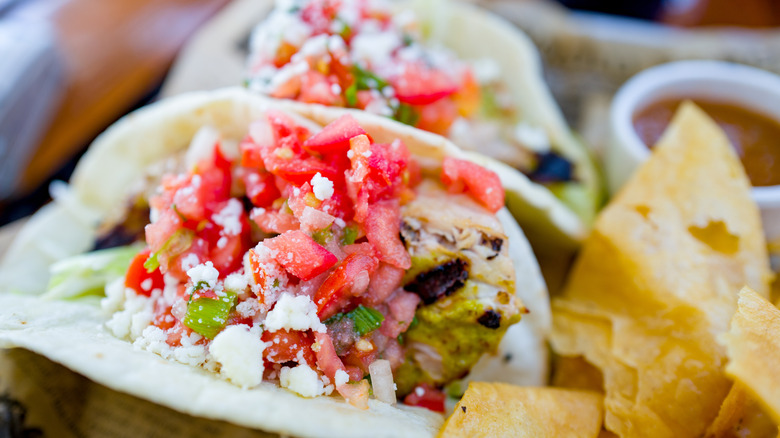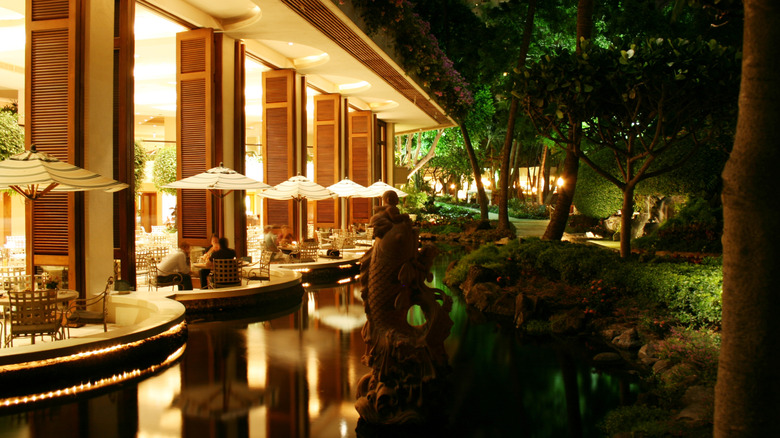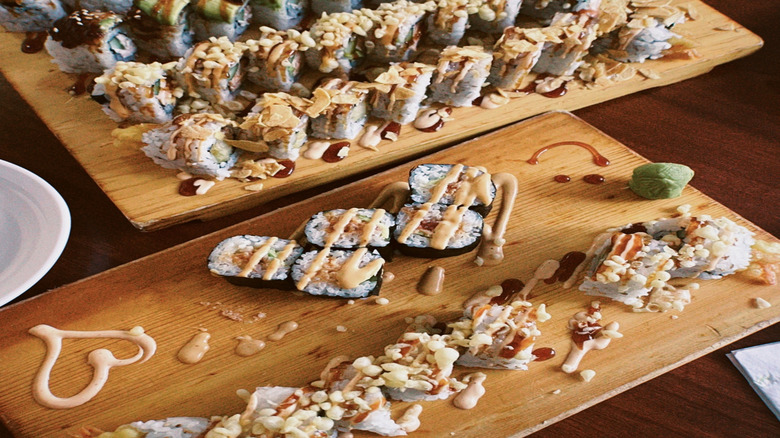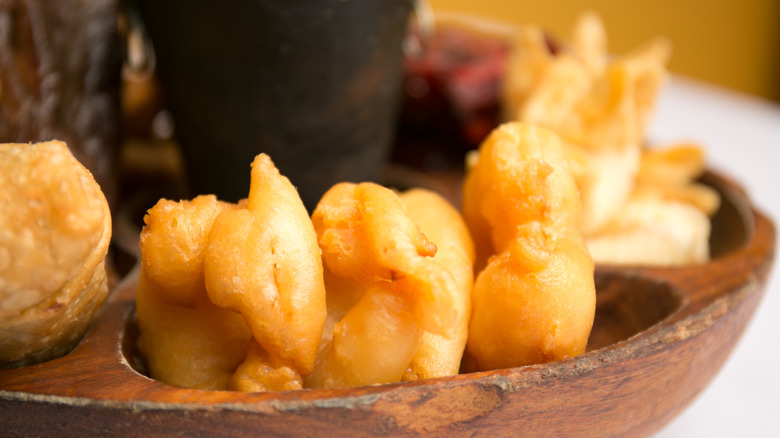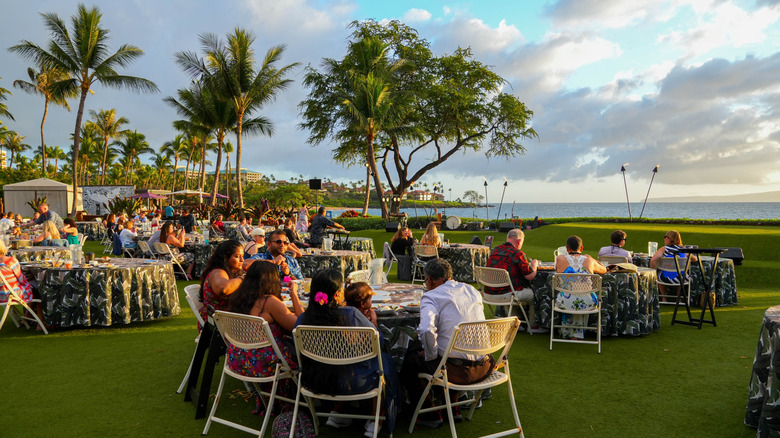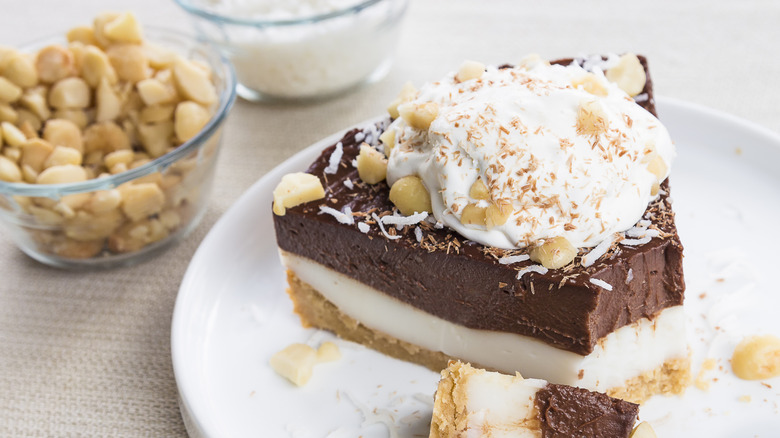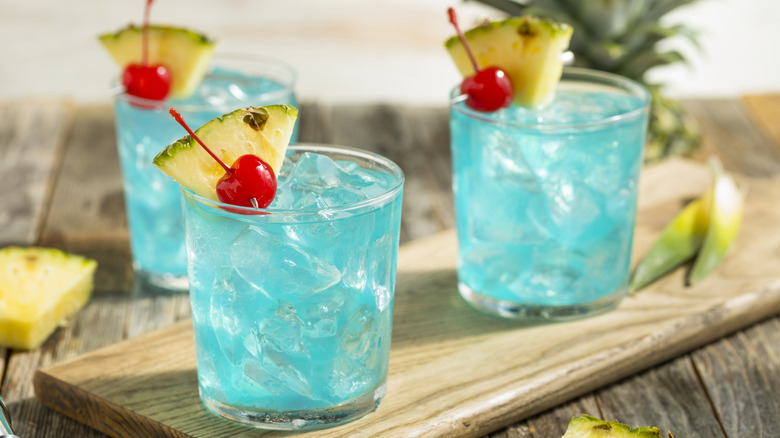What Tourists Visiting Hawaii Can Expect Their Meals To Be Like
Dreamy images of Hawaii's white-sand beaches, lush peaks, and incredible wildlife can dazzle the minds of tourists flying into Honolulu. Anyone going on vacation to Hawaii is likely looking forward to the well-known attractions of this gorgeous island chain. However, one enticing element of Hawaiian culture is often overlooked by visitors, even after arriving on these remote isles — the extraordinarily unique foods of this multicultural archipelago.
Hawaiian cuisine is an alluring hodgepodge of locally sourced foodstuffs and international influences originating from waves of settlers dating back centuries. Native Polynesians tamed these volcanic islands to raise an abundance of tropical crops from Hawaii's fertile soil, while subsequent arrivals from all over the world brought their culinary traditions and favorite ingredients along with them to share. The result is a distinctive array of specialties that reflect the far-ranging tastes of Hawaii's diverse population, often all served together on a single plate.
This overview of what travelers can expect when dining in Hawaii is based on cherished memories of meals enjoyed during explorations of Oahu and Kauai, as well as in-depth research on the archipelago's cuisine. Additional details were provided by contemporary reports about Hawaii's excellent eateries and other dining opportunities, especially when identifying specific establishments offering great grinds that are sought out by refined gourmets and broke surfers alike. Try a variety of local delights while in Hawaii, and you may end up remembering these tropical repasts as highlights of your time there.
Hawaiian cuisine blends island delicacies with global influences
To truly appreciate the cuisine of Hawaii, it's important to understand the history of this faraway string of isles. Rugged groups of Polynesian mariners first discovered the Hawaiian islands around A.D. 400 after crossing vast expanses of the Pacific in outrigger canoes stocked with breeder animals such as chickens and pigs, along with seedlings for crops like breadfruit, bananas, and sweet potatoes. Known as canoe crops, these ancient agricultural imports remain crucial components of Hawaiian cuisine to this day, along with the bounty of seafood that early islanders relied on for delicious sustenance.
Captain James Cook first encountered Hawaii in 1778, and over the following decades, many other swashbucklers and settlers would follow from Europe, the U.S., and beyond. Later, the islands welcomed agricultural laborers from disparate nations like China, Portugal, and the Philippines, all arriving with beloved recipes from their homelands. Hawaii's history of food production led to rich plantation owners and businessmen overthrowing the Native Hawaiian monarchy in 1893, and the U.S. annexed this entire archipelago as a territory in 1898. However, Hawaii's commingling of cultures brought about a truly one-of-a-kind culinary scene that tastefully melds locally harvested ingredients with flavors from distant continents and cooking techniques of diverse communities.
Hawaiian breakfasts range from light to delightfully heavy
Hawaii became a U.S. state in 1959, and while its historic roots as a Polynesian kingdom remain omnipresent, this is now a thoroughly Americanized destination. With that in mind, all of America's classic breakfast foods are certainly available in Hawaii, whether at Denny's locations in Honolulu or at typical hotel buffets. But step beyond your usual comfort zone when ordering morning meals in Hawaii and discover an appetizing world of breakfast foods that range from light delicacies based on local produce to delightfully heavy feasts of savory specialties.
Eating fresh papaya with pineapple cubes and yogurt is one common way of saying aloha to a new day. Acai bowls are another popular breakfast across Hawaii, with a rainbow of island-grown tropical fruits serving as colorful toppings. However, if you're looking for something that will stick to the ribs all day, try Portuguese sausage served with scrambled eggs and rice seasoned with soy sauce, or a plateful of loco moco. That latter dish originated at a Hilo diner in the late 1940s and consists of white rice topped with a beef burger patty, thick brown gravy, and a fried egg. If it isn't in that order, it isn't loco moco.
The plate lunch is a legacy of Hawaii's intercultural cooperation
When international laborers in 19th-century Hawaii would head out to work the fields all day, they'd bring bento-style boxes of leftovers from the previous night's dinner to enjoy during lunch break (along with some rice). These agricultural workers from Japan, China, the Philippines, Portugal, and beyond would all feast together and share their diverse family specialties to create ever-changing repasts of global delicacies, which became a traditional meal beloved across the islands — the plate lunch.
Later, vendors visited the fields to sell plate lunches from wagons, and some of these mobile entrepreneurs added macaroni salad to the mix. This ended up setting the standard for the essential plate lunch format you'll find in Hawaii today: Two scoops of rice, one scoop of mac salad, and a protein-rich entree (although mixed plates are available with additional meat-based options). These entrees can include Chinese char siu pork, Japanese salmon teriyaki, Portuguese sausage, or Filipino adobo, to name but a few plate lunch all-stars. Typically served in styrofoam takeout containers and offered at low-key eateries like the L&L Hawaiian Barbecue chain, plate lunches continue to fulfill their original purpose of feeding busy islanders as they go about their work ... even if these meals are now more likely to be eaten amid office desks or beachside picnic tables rather than out in the fields.
Hawaii is the home of poke bowls
These days, poke bowls are in demand among health-conscious hipsters in many U.S. cities. While these protein-packed meals are often compared to deconstructed sushi, they actually originated in Hawaii long ago, when ancient islanders would devour fresh-caught fish infused with sea salt, seaweed, and roasted kukui nuts. As time went on, agricultural workers from Japan added their preferred raw fish delights to these bowls, along with rice and varied seasonings. As a scrumptious outcome of intercultural culinary contributions, modern poke bowls can contain any number of satisfying ingredients, including noodles, marinated vegetables, tropical fruits, raw or roasted fish, and other proteins ranging from fried chicken to teriyaki beef.
However, classic poke bowls in Hawaii are still based on marinated raw fish served with hot rice, and they're available across the islands at humble hotspots ranging from grocery stores to food trucks. Unlike many poke bowls offered back on the mainland, don't expect to find trendy ingredients like kale, quinoa, or zucchini noodles in Hawaii's original versions. Even so, they're still a healthy and invigorating handheld meal to enjoy on the go. Popular variants found around the islands include poke nachos and poke sliders.
Lunch wagons and food trucks are prized for great Hawaiian grinds
Since the times when enterprising vendors first sold plate lunches to Hawaii's agricultural laborers, mobile food sources have become indispensable purveyors of sustenance across the islands. Lunch wagons continually draw crowds in Honolulu, even if their menus now highlight chic specialties like wood-fired pizzas, pad Thai noodle dishes, or grilled cheese sandwiches stuffed with sliced fruit. Nonetheless, many vendors still serve classic plate lunches to legions of regulars who await favored wagons along their regular routes.
While surf culture has been an essential aspect of Hawaiian society for centuries, hordes of mainlanders flocked to Oahu's North Shore in the 1960s and '70s to discover the world's surfing capital. Here and elsewhere across the islands, a vibrant culture of fun-spirited food trucks has developed over decades to feed hungry surfers, locals, and intrepid tourists alike. Some of the most renowned eateries on wheels include the graffiti-covered Giovanni's Shrimp Truck, the Elephant Shack (often found serving its authentic Thai food beside a Sunset Beach gas station), and Da Bald Guy food truck that offers hearty breakfasts and plate lunches served with proteins like pan-fried poke or furikake crusted salmon.
Poi is a crucial part of Hawaiian cuisine
Taro is an Asian root veggie that was packed among the canoe crops of ancient Polynesian sailors as they embarked on epic journeys across the Pacific. After inhabiting the steep volcanic hills of Hawaii, the islanders built intricate irrigation systems providing fresh water to taro crops planted on terraces that were carefully carved into the islands' volcanic topography. All of this effort was to ensure steady production of a crucial food source for Native Hawaiians: poi.
The starchy tubers of taro are baked, pounded, and blended with water to produce poi, a purple paste of varying consistency that ranges from the thickness of thin pudding to nearly doughy. Taro is rich in vitamins B6, E, and C, along with potassium, magnesium, and phosphorus — so it's easy to understand why poi attained staple status among Hawaiians. Additionally, poi has a pleasantly mild taste with a gelatinous texture that can be almost chewy. When it's freshly made, poi is somewhat sweet, but its taste grows pleasantly sour over time with the onset of fermentation, which results in a greater yield of beneficial probiotics than what yogurt provides. Communal serving bowls of poi are customary at Hawaiian feasts, and it's an excellent accompaniment to pork or chicken dishes.
Snack on a variety of Hawaii's tropical fruits
The balmy climate of Hawaii is good for more than getting a suntan. Varied fruits are always in season across these tropical islands, and the options include edible plant species that may be completely unfamiliar to many mainlanders. Some produce found in ordinary Hawaiian supermarkets may even appear a bit daunting to peel, let alone eat. However, Hawaii's wealth of fruits provides rare opportunities to not only experience entirely new tastes of freshly picked island produce but to sample intriguing fruit flavors from around the world.
Hawaii does not have many native fruits, but the arriving Polynesians brought some species that now thrive there (including bananas and breadfruit), and, in the 1800s, new settlers brought many of their favorite fruit seeds from far corners of the globe to these islands. Some of the extraordinary tropical fruits that are now abundantly available in Hawaii include dragon fruit, mountain apples, passionfruit, lychees, star fruit, mangoes, papayas, and pineapples. The best places to discover these sweet crops are Hawaii's top farmer's markets, where visitors can also admire the striking variety of tropical flowers that flourish in the island sunshine.
Fish tacos fuel Hawaii's legendary surfing scene
Native Hawaiians regarded surfing as an integral aspect of their culture; certain surf breaks were once strictly reserved for members of the nobility. However, in the 1950s, surfing became an American craze from coast to coast. In the following decades, a deluge of youths arrived with surfboards, smiles, and little else to sustain their bohemian beachfront lifestyles. But fish remained a plentiful food source throughout Hawaii, and transplanted Southern California surfers brought a hunger for the tacos popular on Golden State beaches ... so, it's not surprising that affordable fish tacos became a major source of surfer sustenance.
Any visitor to Hawaii can enjoy fish tacos as an excellent way to savor local seafood. Common tortilla-wrapped piscine proteins include mahi mahi, albacore, snapper, and shrimp, all topped with varied spices, sauces, and freshly grown veggies. Best of all, buying fish tacos at Hawaii's finer food trucks — such as Oahu's North Shore Tacos or Ono Tacos on Maui — won't break the bank. Surfers no longer need to belong to Hawaii's elite to enjoy the best breaks around the islands, followed by a seafood specialty fit for royalty.
Fine dining options abound in Hawaii
Of course, anyone looking to splash out on a gourmet meal will have plenty of possibilities to do so when visiting the Aloha State. In addition to upscale resorts offering diverse fine dining options amid settings of incredible coastal beauty, independent restaurants dream up amazing dishes that meld island specialties with global creativity. In the kitchens of these gastronomic destinations, multicultural influences are still shaping the future of Hawaiian cuisine.
One highly recommended spot for refined local flavors is Honolulu's Nami Kaze eatery, led by Jason Peel. A Kauai native who worked as a chef in New York, Dubai, and Thailand, Peel returned to the islands and now uses his world-spanning experience to create novel incarnations of home-cooked Hawaiian meals infused with haute-cuisine flair. Other notable locales for 21st-century fine dining in Hawaii include Hukilau Lanai on Kauai — where fresh seafood dishes are presented with artful expertise — and Merriman's restaurants, sited on several islands as a farm-to-table institution.
Some of the world's best sushi is served in Hawaii
Among Hawaii's fine dining establishments, visitors will find Sushi Sho at the Ritz-Carlton Residences, Waikiki Beach. This exclusive omakase hotspot was established by world-renowned Japanese sushi chef Keiji Nakazawa, who revived the lost art of 19th-century raw fish delicacies sold by Tokyo street vendors. Here, Nakazawa's methods are emulated with Hawaiian ingredients amid a striking atmosphere of curvaceous wooden surfaces and dimly lit earth tones; reservations are essential.
The takeaway? Being relatively close to Japan and sharing long-standing intercultural connections, Hawaii is home to some of the world's finest sushi — and considering the bounty of fresh fish to be enjoyed here, it's a perfect place to sample some nigiri or maki. There are plenty of options for getting sushi beyond upscale eateries, as well. Just check out the food items at 7-Eleven gas stations in Hawaii to find Spam musubi, a sushi-styled treat comprised of the namesake canned meat wrapped in nori seaweed along with white rice and furikake. This is a staple snack across the islands and one of the main reasons Spam is so popular in Hawaii.
A pupu platter is Hawaii's shaka charcuterie
All right, let's get this out of the way — when it's first heard of by English speakers, the pupu platter may sound somewhat less than appealing. All snickers aside, "pupu" is derived from the Hawaiian word for "appetizer," and a typical platter is overloaded with an assortment of island specialties mixed with Chinese delights, like fried shrimp, egg rolls, spareribs, chicken skewers, and fried dumplings. Sometimes, the serving dish contains its own small hibachi to warm up morsels chosen from this mini smorgasbord of tiki bar food.
Other treats you'll find on Hawaiian pupu platters include cone sushi, boiled peanuts, char siu, edamame, crab rangoon, and barbecued chicken wings. In short, every pupu platter bears a unique blend of delights from around the Pacific Rim and beyond, representing much of Hawaii's multicultural culinary scene on one magnificent tray. Similarly to charcuterie boards, locals create festive-looking pupu platters as eagerly anticipated offerings for potlucks or parties, while some Hawaiian hangouts specialize in serving pupu dishes with drinks.
Lū'au feasts can be wonderful, but look out for tourist traps
There is no meal more closely associated with Hawaii than the feast enjoyed at a lū'au. Amid performances by fire jugglers and hula dancers swaying to traditional island music, diners peruse a sprawling buffet of Hawaiian delicacies like roasted pork, pipikaula dried beef, pan-seared seafood, and huli-huli chicken, all served alongside a fresh poke bar. These open-air celebrations can be wonderful, and they are deeply ingrained into the expectations of countless Hawaii visitors. Naturally, hospitality entrepreneurs meet this demand by operating numerous lū'au experiences across the islands, with typical prices far exceeding $100 per person.
Unsurprisingly, some of these lū'au stagings rank among the worst tourist traps to skip when visiting Hawaii, as they exploit Native culture for profit. Plenty of online reviews make it clear that many over-commercialized lū'aus are rip-offs with inferior food. Make sure to carry out extensive research to find Hawaii's authentic lū'au celebrations that appropriately reflect the genuine artistry and cuisine of island culture. And remember that when attending any lū'au, visitors should respect these feasts as a multisensory representation of the Native community's traditions.
Hawaii's unique sweets incorporate island delights
Anyone with a sweet tooth will be spoiled for choice in Hawaii. Sugarcane was one of the canoe crops that arrived aboard ancient Polynesian outriggers, and sugar remains a cherished ingredient in countless desserts of the islands. From the iconic guava chiffon cake to the widely beloved chocolate haupia pie infused with coconut milk, plenty of classic Hawaiian confections offer unforgettable tastes of the islands.
In addition to sweets that showcase Hawaii's fruit flavors, plenty of sugary international delights are also ubiquitous on the islands. Doughy Portuguese malasadas are a longtime favorite, while Japanese mochi has taken on its own character here since it first arrived long ago. If you only have the chance to try one sweet treat during your visit (which is unlikely), remember that humble shave ice is the ultimate must-eat in Hawaii — seek out vendors topping icy scoops with homemade syrups derived from a cool range of island fruits like mango, guava, and pineapple.
Enjoy meals with classic cocktails of Hawaii
Tiki drinks are a crucial element of Hawaii's most kitschy attractions. While many of these Polynesian-themed potent potables are anything but authentic relics of local culture, they still look fun and are refreshing to sip on when sunbathing poolside. The cocktail that is likely most affiliated with Hawaii is the mai tai — a delicious blend of rum, orange liqueur, orgeat, lime juice, and simple syrup. Who cares that it was actually invented in Oakland, California?
On the other hand, the eye-catching blue Hawaii cocktail was first created at a Waikiki Beach resort, making it a truly local concoction of vodka, light rum, sweet and sour mix, and blue Curacao. Other classic Hawaiian cocktails include the tropical itch (featuring bourbon, rum, triple sec, and bitters blending with passion fruit puree, pineapple juice, and lemon juice) and the rum-rich lava flow with flavors of strawberry, pineapple, and coconut. Teetotalers need not refrain from enjoying these revered beverages; many tiki drinks can be made in nonalcoholic versions.
